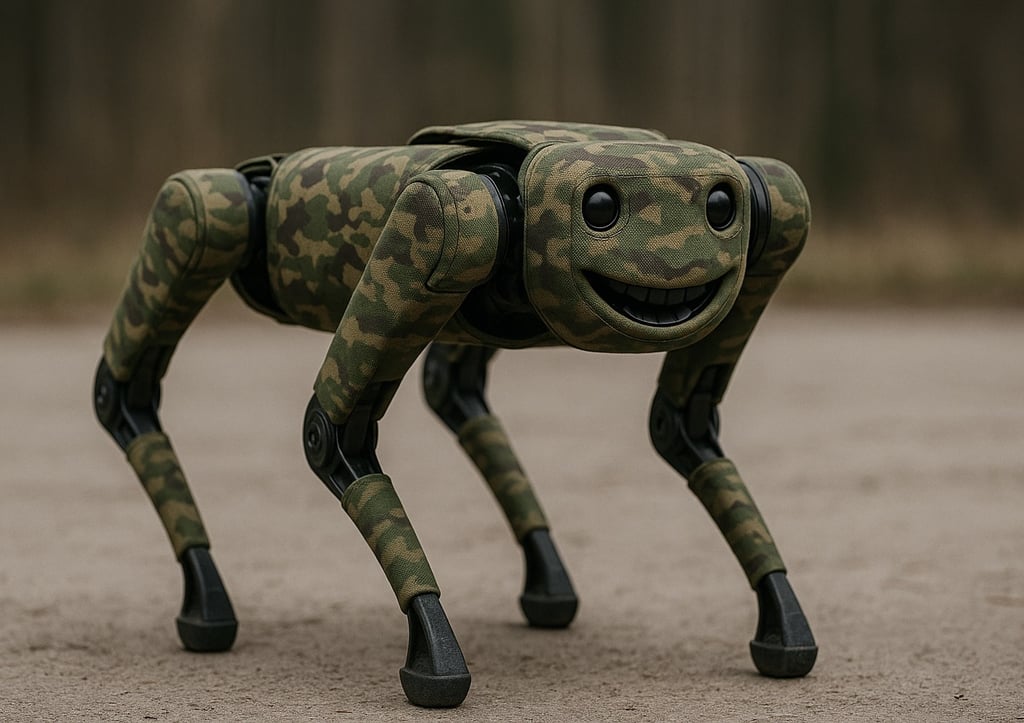First They Fetch, Then They Fight: The Dog-Eared Dawn of Robot Warfare
First they fetched, then they fought. Ukraine’s robot dogs are redefining war cheap, tireless, and unsettlingly loyal. A glimpse of a future where battles are fought by machines, nations compete by output, and Orwell’s nightmares finally a prototype.
MILITARYFUTURE AND TECH
10/26/20253 min read


Ukraine’s trenches now have four legs and no heartbeat. The machines scuttling through smoke and mud aren’t the glossy Boston Dynamics prototypes with inspirational background music, they’re cheap, off-the-shelf quadrupeds like the Unitree Go2 and the BAD-series rigs, stripped down and wired up for war. What began as an engineering curiosity is now government policy: mass-produce expendable, semi-autonomous ground robots that can scout, carry ammo, or crawl into a trench where no sane person would. Ukraine’s target is 15,000 units by 2025, which is roughly 15,000 reminders that the future of warfare is affordable and comes with a rechargeable battery.
For now, these robots play the role of brave assistants, fetching, dragging, and occasionally exploding for their human masters. They crawl through minefields, ferry supplies under fire, and pull wounded soldiers to safety, the kind of jobs a human used to perform with a healthy dose of dread. They’re introduced, as all new technologies of violence are, under the banner of “saving lives”. And it’s true, they do. But history tends to treat these “support” roles as the larval stage of something far less charming.
It always starts this way: robots help humans. Then, inevitably, they replace humans at the front line, because they don’t tire, they don’t flinch, and they don’t write letters home. Once they’re taking the bullets meant for us, the next logical step is for them to start shooting back. And after that? They start shooting at each other. At that point, war stops being about ideology or territory and becomes a grotesque industrial sport, a competition of who can outmanufacture whom. When the factories become the front, humans become the spectators.
That’s when the world starts to look disturbingly familiar. Orwell imagined a future where nations fought endless wars, not for victory, but to consume the output of perpetual production, a mechanism of control through exhaustion. This is how you get there: robots fighting robots while civilians queue for rationed power to build more robots. Nations locked in elegant stalemate, maintaining deprivation at home in the name of efficiency abroad. The military-industrial treadmill doesn’t need soldiers anymore; it just needs subscribers.
What makes this new arms race so grotesquely efficient is how mundane it looks. These are not high-end killing machines; they’re running on consumer-grade hardware, sometimes literal Raspberry Pi-level boards. The line between gaming PC and battlefield AI is thinner than a firmware update. Losing one costs less than a night in a decent hotel, so commanders can afford to send them in waves. It’s attrition through affordability, the kind of logic that would make an accountant blush and a general smile.
Their uncanny movement is part of the strategy. Troops describe seeing one crawl out of the mist as “like watching a nightmare evolve legs.” The quadrupedal shape plays tricks on the human brain, recognisable enough to feel alive, wrong enough to feel predatory. It’s the uncanny valley turned into psychological warfare.
Ukraine’s model, rapid iteration, low cost, user feedback from the front, is what Silicon Valley would call “agile development”, just applied to death. The country’s success has already become a case study in military decentralisation: forget the massive R&D pipelines of superpowers; just modify commercial drones and robots fast enough to stay ahead. Smaller nations are watching closely. Once you can print, code, and ship robotic soldiers faster than you can train a human, manpower stops being a strategic advantage, population becomes an inefficiency.
And so, quietly, the old dream of robotic warfare, the one Hollywood warned us about, has arrived wearing a hi-vis vest and carrying medical supplies. Oh, how disappointingly realistic it all turned out to be. We thought the future of war would look like Terminator; instead, it looks like Amazon Logistics with PTSD.
Give it a few more years. The first stage is the helper dog. The second is the attack hound. The third is when the dogs start fighting other dogs while we count the invoices. That’s the point where humanity officially steps off the battlefield and onto the production line, manufacturing its own obsolescence under the banner of “efficiency.”
And when the balance of power depends not on courage or conviction but on factory output, Orwell’s prophecy will have found its mechanical form. Endless war, endless scarcity, endless obedience, maintained not by ideology, but by logistics.
So yes, the future has four legs. And it’s marching towards us faster than we can build an off-switch.
BurstComms.com
Exploring trends that shape our global future.
Sign up for the regular news burst
info@burstcomms.com
Get the next transmission:
© 2025. All rights reserved.
